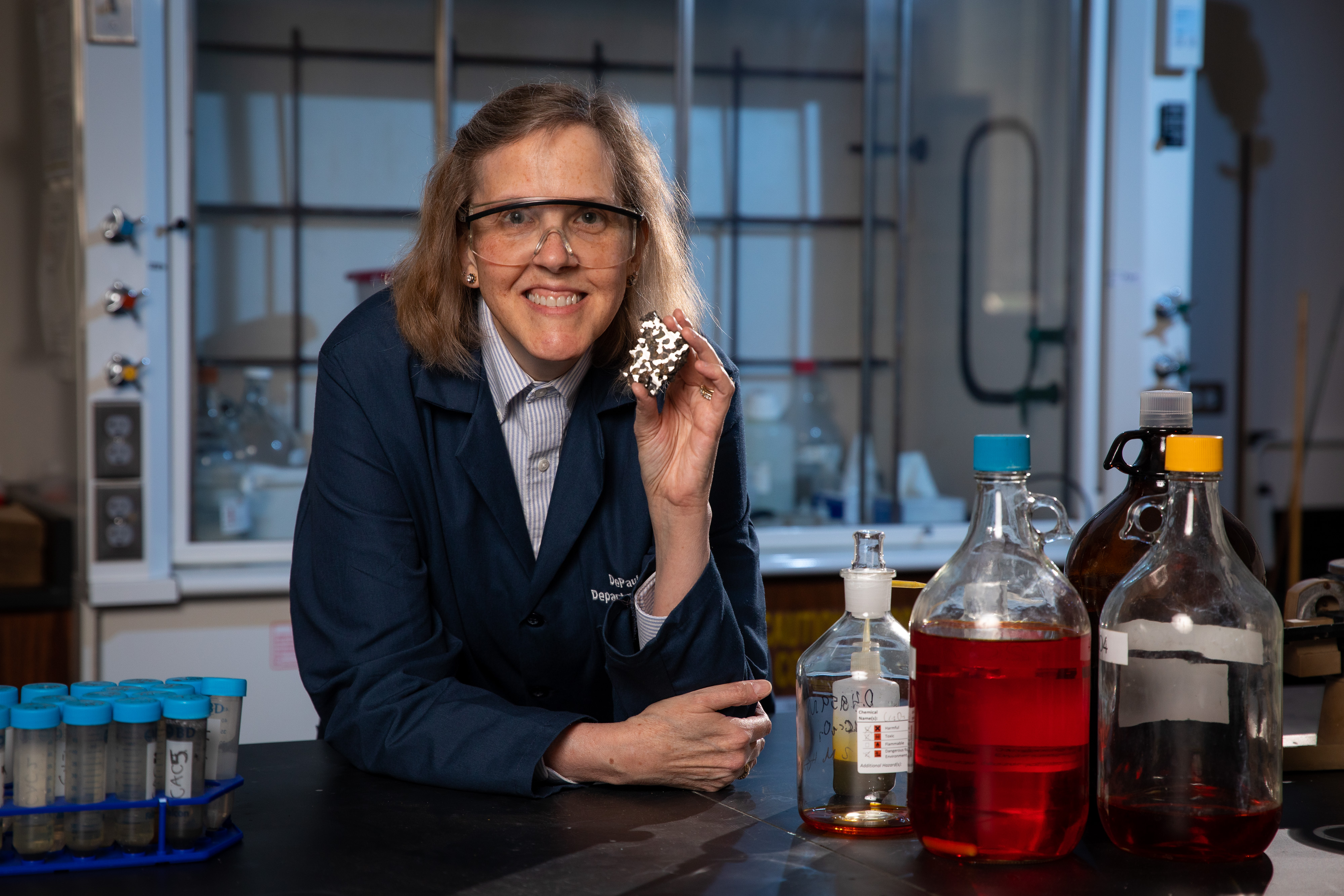 Chemistry professor Wendy Wolbach holds a slice of a stony-iron meteorite called a pallasite, which originated in the asteroid belt and is on loan from the Field Museum. In her DePaul lab, Wolbach works with items archaeologists find at sites of high-energy impacts, including asteroids that collide with Earth. (DePaul University/Jeff Carrion)
Chemistry professor Wendy Wolbach holds a slice of a stony-iron meteorite called a pallasite, which originated in the asteroid belt and is on loan from the Field Museum. In her DePaul lab, Wolbach works with items archaeologists find at sites of high-energy impacts, including asteroids that collide with Earth. (DePaul University/Jeff Carrion)
Over the summer, TV favorite "Jeopardy!" launched a new category: Science and the Bible. Chemistry professor Wendy Wolbach works with archaeologists to discover evidence of asteroids and other high-energy impacts from ancient times. It was no surprise, then, that "Jeopardy!"
cited her work in this clue:
"A 2021 study suggested that an asteroid that struck the Jordan Valley c. 1650 B.C. gave rise to the story of this city in Genesis 19." If you answered, "What is Sodom?" then your hunch is the same as Wolbach's.
"The theory is that maybe there was an extremely destructive air burst," Wolbach says. "There were 2,000-degree temperatures that melted pottery and eroded meters-thick walls. Human skeletons were pulled apart — just very violent." This aligns with the Biblical story of fire and brimstone raining down on the "wicked city of Sodom."
Digging for clues
"We're not claiming in the paper that this is definitely Sodom," Wolbach says. "But many in archaeology are interested in how the written record might derive from historic events."
Wolbach is part of the Comet Research Group, an international consortium that draws from many disciplines, including chemistry, geology and others. The group and Joel Kathan, now a DePaul alumnus and a student at the time, co-authored the study published in the nature journal "Scientific Reports."
Joking that she's an armchair geologist, Wolbach is trained as a chemist and has never done field work. Instead, samples are sent to her lab in Chicago. She has worked on several studies with the consortium, including research on the Tunguska, Russia, explosion of 1908. Scientists extensively studied that site, where an object hit and created 1,000 times more energy than the Hiroshima atomic bomb.
Some similar findings from the Russian explosion have been found at the site in Jordan. In her DePaul lab, Wolbach and Kathan dissolved excavated sediments from the site and searched for soot, shocked quartz and nanodiamonds — all signs that would point to a high-energy event. The research at that site is ongoing as archaeologists continue to excavate.
Dinosaurs, soot and launching student research
Important research is rarely fast-moving and can be discouraging to young scientists. Wolbach encourages her students to stick with their research. In her days as a grad student in the 1980s, Wolbach searched for answers about the demise of the dinosaurs amid emerging theories at the time about the role of meteorites in the extinction. It took her two years to identify a black substance in the rocks.
"I was trying to see if tiny bits of meteorite might have survived in rocks. Instead, I found huge amounts of soot," she says. This pointed to a widespread conflagration that likely wiped out the dinosaurs and was potentially caused by a meteorite. Her findings were a breakthrough and drew national attention and media coverage from
The New York Times and
National Geographic.
Wolbach went on to apply this approach to other eras, much of it tied to the Ice Age. Close to 14,000 years ago, there was a megafauna extinction including the death of the woolly mammoths and giant sloths. The rock strata, called the Younger Dryas boundary, spanned the United States and Northern Europe. "We are still seeking to understand if there might have been another sort of airburst or impact that contributed to the end of the Ice Age."
While Wolbach is not an avid "Jeopardy!" viewer, she was happy to see the show feature the Comet Research Group's study. She continues to work with the consortium on research from the Jordan site. Since joining DePaul in 1999, Wolbach has brought her research into the classroom and students into the lab whenever she can.
"Starting as an undergraduate researcher solidified my interest in being a chemistry major and getting a Ph.D.," Wolbach says. "Conducting research with students is a way to give back and give them opportunities as well."
Read more about undergraduate research at DePaul.
Kristin Claes Mathews is assistant director of news and integrated content in University Marketing & Communications.